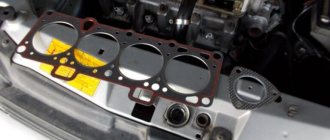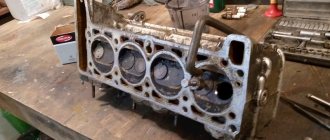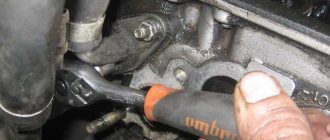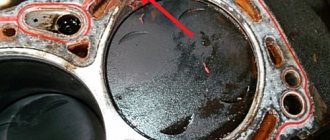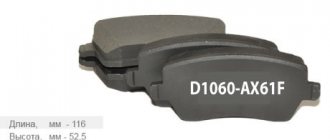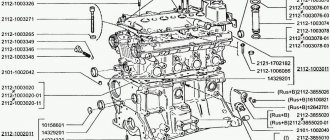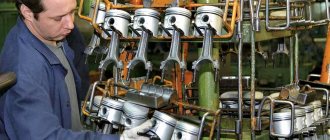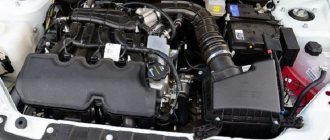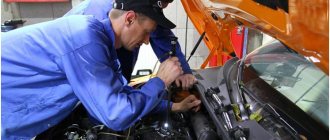When is it time to change?
The gasket serves to seal the connection between the head and the cylinder block. There are several types of it:
- Asbestos. The main advantage: minimal shrinkage and excellent recoverability.
- Metal. These are some of the most reliable and high-quality consumables.
New metal cylinder head gasket - Non-asbestos. Used as repair kits. Main advantages: elasticity, heat resistance, elasticity.
The procedure for replacing the cylinder head gasket on a VAZ 2112 16 valves is indicated in the manual, but this is not the main reason. There are a number of signs that determine the need for replacement:
- leakage of engine oil or antifreeze in the connection area;
- white steam present in the exhaust gases indicates that antifreeze has entered the cylinders;
- when exhaust gases enter the cooling system, foam appears at the neck of the expansion tank;
- the presence of oil stains in the coolant indicates a leak in the connection;
- the presence of a white coating on the oil dipstick indicates that there is antifreeze in the engine oil; this may be due to a damaged gasket.
Replacement intervals for the cylinder head gasket on the VAZ-2110
Repairing the cylinder head from “a” to “z”
It is very difficult to predict the exact service life of the gasket.
The most important thing that interests owners is the replacement interval for this part.
- Manufacturer of the part.
- The quality of the material from which the gasket is made.
- The conditions under which these parts were stored.
Since the gasket is made of rubber, storage conditions directly affect its service life. For example, a part purchased at the market, which was stored for a long time in a damp and unheated container, will be worse than the same spare part purchased in a store.
The main function is to ensure maximum sealing of the cylinder block with the cylinder head. If you do not monitor the condition, the engine life will be significantly reduced.
Signs of a broken gasket
Foam around the expansion tank cap is one of the signs of a cylinder head gasket failure.
You can find out that the seal of the connection is broken for the following reasons:
- White vapor appears in the exhaust gases.
- You may notice oil stains in the antifreeze.
- Leak in cylinder head connections.
- There is a large amount of oil in the pan.
- You may notice foam around the filler cap.
Although it seems that it is very difficult to notice the vapors in antifreeze, this can be done by placing a bag over the neck of the open expansion tank. If there are gases in the antifreeze, the bag will inflate.
Frequency and reasons for replacement
According to official regulations, the cylinder head gasket of a VAZ 2112 engine can last 200 thousand kilometers. Usually, after traveling such a mileage, the service life of the seal is exhausted.
For what reasons may it be necessary to replace it:
- Natural wear and tear. Any part or machine assembly has a certain service life. Natural wear and tear cannot be avoided.
- Damage to the cylinder head, deformation or deflection. This may cause the gasket to break and hot coolant to get onto its surface.
- Boiling of the power unit. Regular driving of a car with an overheated engine will cause damage to the sealing element.
Signs of replacement
By what “symptoms” can you understand that it’s time to change the BC head gasket:
- Leakage of motor fluid or coolant at the junction of the head connection with the block itself. If you see oil stains at the point of contact between the cylinder head and the cylinder head, diagnose the condition of the power unit.
- White smoke comes out of the exhaust pipe of the car, almost steam, uncharacteristic of exhaust gases. This indicates that coolant has entered the engine cylinders.
- The presence of foam in the area of the neck of the expansion tank in the engine compartment of the car. The substance foams as a result of exhaust gases entering the cooling system through a broken seal.
- The presence of greasy oily spots in the antifreeze, which indicates a poor connection and lack of tightness.
- A white coating has appeared on the engine fluid level dipstick. This indicates that refrigerant has entered the lubricant. This is usually the result of a damaged gasket.
conclusions
Please note that upon completion of the work, it is necessary to install a new cylinder block gasket, carry out all work in strictly the same order as removal, and also pour new coolant into the system and check all connections for leaks.
Despite the fact that this work is quite difficult due to the dismantling of numerous pipes, pads and threaded connections, it is very doable with your own hands, you just need to read our article very carefully and you can get to work without fear.
Features of repairing the cylinder head of the Lada Granta
The engine of the Lada Granta car has differences with the Kalina engine. The block head, in comparison with the Kalinovskaya one, has been increased in height by 1.2 mm. This is due to a change in the combustion chamber. Lightweight pistons installed. The timing belt has been modified and operates in a temperature range from minus 40 to plus 40 degrees. The declared belt mileage is up to 200 thousand kilometers.
The main feature of Granta cylinder head repair is the use of metal-ceramic seats. By car Kalina, 2114, etc. Cast iron saddles are used, which can be processed manually using a set of domestic cutters.
Machining cermet seats requires wear-resistant cutting tools. In order to successfully process them, the head is installed on the NEWENContour-BB machine, designed specifically for the rapid processing of seats and guide valves with digital control or manually with a Neway tool.
Cleaning valve channels
To remove any valve, you will need to remove the camshaft. All screws on the bearing housing must be unscrewed evenly and tightened with a force of 10 N*m. The hydraulic compensator can be removed with a magnet, and then the valve is desiccated by compressing the spring with a puller (see photo).
How to remove the valve
There may be carbon deposits in the valve channels. It is cleared:
- Flat screwdriver;
- Sanding felt.
Grinding is carried out as follows: a rubber pipe is placed on the valve, a paste with diamond chips is applied (one drop), then the valve is pressed into the channel and scrolled. It will also be possible to change the valve stem seals (2112-1007026). You can’t do this without a special puller.
Cap puller
On any car, including the VAZ-2112, cylinder head repair comes down to cleaning and checking, as well as correcting geometry defects. In the latter case we are talking about milling. The presence of cracks and chips is a reason for replacement, not repair.
A small photo report
A burnt valve is immediately visible.
One valve burned out in cylinder 2
Carbon deposits were found in each valve channel.
Carbon layer in the cylinder head channels
Repair: cleaning all channels, replacing the valve with lapping. Direct repair of the VAZ 2112 cylinder head will require several operations that require some special equipment. Of course, this is not possible at home, and car enthusiasts simply replace worn parts. Next, we will consider the process of repairing the block head, as well as some of the nuances associated with this work.
Stages of block head repair
Before proceeding directly to the cylinder head repair process, it is worth noting that the head must be completely disassembled and all the necessary spare parts purchased. Let's consider the process of complete overhaul of the cylinder head.
Washing and crimping
The process of washing automobile spare parts with hot kerosene
In order to wash the head, it must be completely disassembled, that is, all parts that can be easily removed must be dismantled. For a complete wash you need 12 liters of hot kerosene. At car services, this is done using a sprayer that supplies liquid under pressure. This way, all the dirt and remaining metal shavings are washed away. The washing is carried out until the cylinder head is completely clean.
The process of crimping the cylinder head
Crimping is a process in which the integrity of a part is checked. Pressure testing can be carried out in two ways, which are basically similar. The first is to close all the cracks and fill the part with water. If there is water leaking or leaking somewhere, then the integrity has been compromised and repairs are necessary. The second method is to close all the cracks and immerse the head in an aqueous solution. It will be immediately obvious where the part is depressurized. If the integrity of the head is damaged, it must be restored.
Removing saddles
Before moving on to the rest of the overhaul steps, the valve seats must be removed. In the best case, they will easily be knocked out of their seat, and if not, then you will have to use Russian ingenuity.
The valve is welded to the seat and knocked out of the seat
So, what to do if the valve seats do not come out? The solution is simple. It is necessary to weld a tube to them so that the working end passes through the channel of the guide sleeve and knock it out until the seat comes off the mounting mount. Of course, cracks may form on the seat ring or a piece may break off. After completing the procedure, it is necessary to inspect the place and, if necessary, weld it with argon welding.
Self-repair of cylinder head
Every domestic car enthusiast has standard auto mechanic skills and is able to carry out cylinder head repairs with his own hands; to do this, you need to carefully study the stages of work described below, which are conventionally divided into: preparatory, dismantling, repair and installation.
Preparatory stage
They start by driving the car into a room with an inspection hole, turning off the power to the on-board electrical network (removing the terminals from the battery), unscrewing the engine crankcase protection and draining the oil and coolant from it, which is done into previously prepared containers through special technical plugs in the crankcase. These works should be carried out exclusively on a cooled engine, this will prevent your hands from getting burned from heated (usually up to 60-80ºС) liquids.
Dismantling
It begins with the removal of all cylinder head attachments (intake and exhaust manifolds, radiator pipes, air filter duct, high-voltage wires and spark plugs), timing belt protective cover, resulting in access to the valve cover fasteners. We unscrew the tension roller of the generator and timing belts, remove them, then proceed to dismantle the valve cover fastenings, unscrew them, gaining free access to the cylinder head bolts. We unscrew them, after which the cylinder head can be removed from the engine crankcase.
Repair
The cylinder head removed from the engine and placed on a workbench is disassembled. The fasteners of the camshafts are unscrewed and they are carefully removed, then the hydraulic compensators are removed from their seats and, using a screw depressurizer, the valve retaining rings (crackers) are dismantled, after which they are pulled out from their workplaces. After disassembling the cylinder head, we thoroughly clean it of technical contaminants. Each new valve must be ground into its working surfaces; this is done using a drill and a special grinding paste.
Having finished sanding, the working surface is thoroughly wiped with a cloth. All new parts are installed on the cylinder head. The timing mechanism (valve lifters, hydraulic compensators, camshafts and their front seals) is reassembled and the cylinder head is ready for installation on the engine.
Installation
They start by cleaning the surface of the engine crankcase from gasket remnants and traces of leaks of technical fluids, then a new cylinder head gasket is installed in the seat and the assembled head is carefully put on special guides, after which, according to a special scheme, its mounting bolts are tightened with a torque wrench to the required forces.
The next step is to install the timing belts and generator, screw all the attachments into place, pour new oil and antifreeze into the engine, start the engine and carefully monitor it for fluid leaks and extraneous noise. Also watch the video of replacing valves on a VAZ 2112 (16-valve):
Installation and dismantling procedure
The part called the cylinder head is attached to the cylinder block with 10 screws. They are unscrewed with a 10mm socket wrench. The procedure for dismantling the cylinder head is shown in the first photo.
Reversal sequence (1-10)
The standard screw length is 93 mm. If the screw has been pulled out to at least 95 mm, it is replaced with a new one (AvtoVAZ requirement).
During installation, a different scheme is used (photo 2). Each screw is lubricated with machine oil, otherwise the efforts will be reduced to nothing.
The order of tightening the head is indicated in this photo
Selecting a cylinder head gasket
Before you start choosing a head gasket based on the catalog number, you need to consider what types of gasket materials there are. Let's look at the main types of cylinder head gaskets:
- Asbestos. The main advantage: minimal shrinkage and excellent recoverability.
- Metal. These are some of the most reliable and high-quality consumables.
- Non-asbestos. Used as repair kits. Main advantages: elasticity, heat resistance, elasticity.
Metal cylinder head gasket
So, now you can consider the original gasket, as well as the substitutes that are used. Basically, all manufacturers label gaskets according to the original.
2112-1003020 is the original and analogue catalog number of the cylinder head gasket for the VAZ-2112. Also, the manufacturer Ajusa (10144200) produces a range of gaskets for the 2112 model.
Tightening torque for cylinder head cover bolts
For VAZ-2112, the cylinder head tightening torque is standardized:
- First pass – the force is 20 N*m;
- Each screw is turned 90 degrees to the right;
- Wait 20 minutes, then turn the screws another 90 degrees.
At first the effort is very small. But at “step 3” it will be difficult to cope with the work. Use the lever.
Reasons for failure
There are not many reasons why the cylinder head gasket failed, but every car owner must know them. So, let's look at the main ones:
- Wear. Each element of the car has its own service life, and therefore wear of the part is simply inevitable.
- Deflection or deformation of the cylinder head can lead to gasket breakdown or hot antifreeze getting onto its surface.
- Boiling your car can cause the gasket to fail.
Why are guide bushings needed?
Before installing the cylinder head, perform the following steps: clean the threaded holes, as well as all holes for the bushings (photo 1). Each bushing is installed in place, and only then a gasket is placed on top.
Everything is ready to install the cylinder head
Metal parts adjacent to the gasket must be degreased. We looked at the cylinder head tightening diagram, but the cylinder head itself must be installed correctly:
- We place the cylinder head on the cylinder block;
- By moving the part in different directions, we ensure that the bushings fit into the recesses.
After “step 2” the screws can be tightened.
Sealant
No sealing compounds are used when installing the gasket! Solidol, CIATIM and other lubricants are not even needed. The main thing is that the metal must be degreased. And the cylinder head gasket must be new.
Tightening process and diagram (on a 16 valve car)
16 valve engine of the VAZ 2112 car
But before you start the procedure, you need to emphasize that each motor has its own torque and tightening pattern. As you might have guessed, this point will be different for each vehicle. In addition, several factors directly influence the torque indicator, and if you decide to engage in this process yourself, then it will be useful for you to learn about them:
- The tightening torque of the head is affected by the lubrication of the holes for the pins, as well as their condition, and, of course, the quality of the bolts themselves. In order for the torque to be set correctly, both the pins and the holes for them must be lubricated, and regular motor oil will do for this.
- If the thread of the hole or the pin itself is deformed, then it is better to refrain from the tensioning procedure. One way or another, over time this will lead to negative consequences.
Loading …
Required Tools
And, although this procedure requires a certain approach, its preparation will not take much time. The bottom line is that a large set of tools is not required directly to tighten the head pins. The only thing you need is some motor fluid and a special torque wrench.
Torque wrench for work on a 16-valve engine
If you do not have such a key, then you need to buy it in advance or borrow it from a car service center. You need just such a tool, since it allows you to determine exactly the tension moment. Currently, a more budget version of this tool costs about 200-250 hryvnia (600-800 rubles).
Stages
If you removed the head of the 16-valve VAZ 2112 engine, then first of all you need to install it in place.
- Before the actual process of tightening the head pins of a 16-valve engine, their length should be measured. The standard screw length is 135.5 mm. Be sure to check it out. If the length of the pin differs from the above, that is, either more or less, then the pin must be replaced with a new one.
- Take engine fluid and apply it to the bolt threads. This can be done using a brush.
- After this, you can begin installing screws on the 16-valve engine. Tighten them by hand first, then use a torque wrench. The tension torque should be 20 Nm + (69.4 - 85.7 Nm) + 90°+ 90°. That is, tighten the pins, observing the indicators 20 Nm + (69.4 - 85.7 Nm) in accordance with the data on the torque wrench, then turn each screw twice by 90 degrees. As for the tightening order, it is as follows. First you need to tighten the two middle pins starting with the bottom one. Then tighten the two screws on either side of the bottom pin in order. After this, the screws located on the sides of the upper middle pin are tightened. And then, in order, you need to tighten the bolts located at the corners of the cylinder head. The tightening torque procedure is shown in more detail in the photo.
Remember that this component of the VAZ 2112 vehicle is one of the main mechanisms that determine the operation of the engine. Therefore, this issue of repairing the cylinder block should be approached with special care. If you do not have experience in carrying out such work, then it is better to entrust the matter to a qualified professional. After all, very often inexperienced motorists try to save money on repairs, which ultimately leads to even more disastrous consequences.
For example, if the screws are not tightened, this can lead to engine oil leakage and, as a result, condensation. And the appearance of moisture in the internal combustion engine will not lead to anything good. If the screws are overtightened, this may cause cracks to appear, which will necessitate repair of the unit.
Let's move on to the cylinder block
We remove the pallet. Rotating the crankshaft as it is convenient for us, unscrew two bolts on each connecting rod cap. We use a TORX E10 head for this.
We take out the pistons along with the connecting rods. To do this, use the wooden handle of a hammer to press the connecting rod from below and lightly tap it to knock it up. We remove the old liners and buy new ones of the same size according to the markings on them. Here is another stone in AvtoVAZ’s garden, the owner has never climbed into the car from the interior or into the engine, but three pistons were of group “B” and one was “C”. It turns out that at the factory they re-sharpened one cylinder a little and simply put an enlarged piston there, no words. There are no options, we take group “C”, don’t sharpen the engine because of this. We will not touch the main liners either.
We buy a new piston group that does not bend the valves, connecting rods and connecting rod bearings.
Eliminating longitudinal play of the crankshaft
It was noticed on this motor. To eliminate it, replace the thrust half-rings. Standard and repair sizes are available. We take the first repair size, if they are too tight we sand them down a little. We unscrew the middle main bearing and gently push it with a screwdriver and move the half rings. The mark on it is in the form of three serifs, shown below.
When the half ring comes out a little, turn the crankshaft, it will push it out. There are two types of half rings: white at the front and yellow at the rear; the grooves on them should point towards the crankshaft cheeks.
We install them as we removed the new half rings; if they go in with great effort, you can grind them a little on a small abrasive stone, but not from the side of the grooves. Checking the play.
We tighten the main bearing with a torque of 8 kgf*m.
Assembling the piston
There is an arrow stamped on the top of the piston; it should be directed towards the front of the engine. And there are marks on the connecting rod that should look the same way.
Don't get confused!
We insert one retaining ring into the groove on the piston. We insert the connecting rod into the piston and, having lubricated the connecting rod and the piston pin with oil, insert it into place. Insert the second retaining ring. Although this operation seems simple, it will take some pains. We inspect the assembled structure; all retaining rings must be clearly in their grooves, otherwise a ring that has jumped out while the engine is running can cause a lot of trouble.
After assembly, you need to break off the connecting rod bearing cap, since the connecting rod is made in one piece. It's like that on our cars. First, unscrew the bolts. We insert the connecting rod into the cleats at the level of the mark shown in the figure with the black arrow and lightly clamp it, then break it off with a slight movement of the hand. The first time is very scary. We put the cover in place and tighten the bolts so as not to mix it up in the future.
Checking the thermal gap in the piston rings
We lay out each set of rings for each cylinder.
In the future we will not change their places.
In turn, we insert each ring into its own cylinder and push it a little with the piston approximately to the middle.
We measure the gap with feeler gauges.
Nominal clearance: 0.25 - 0.45 mm.
The maximum clearance for all is 1 mm. But this already smacks of waste.
Installing new rings
First, install the oil scraper ring expansion spring, then the ring itself. The oil scraper ring lock should face the opposite direction of the spring lock. Then we install the lower compression ring and finally the upper compression ring.
The inscription “TOP” must be stamped on the rings; it must face up.
The rings in the piston grooves must rotate easily.
How to tighten the cylinder head bolts
Be sure to tighten according to the diagram given in the article. To tighten the bolts, you need to follow a few simple steps:
- Install a new head gasket and place it on the centering bushings.
- Install the head and tighten its mounting bolts.
- Start tightening with a torque of 20 N*m. If the scale is in “kgf/m”, then divide by 10.
- In the second run, you need to tighten all the bolts according to the diagram by 90 degrees.
- During the third pass they turn another 90 degrees.
Bolts with a length of 95 mm or more cannot be used. In general, the procedure is quite simple, but a torque wrench is required - without it, it will not be possible to maintain the correct tightening torque of the VAZ-2112 cylinder head (16 valves).
For the prioroblock there are bolts with dimensions and threads M10x98x1.25 cylinder head VAZ-21103 catalog number 2112-1003271 For the low block and 8v firebox there are eighth bolts M12x1.25x133 mm Cylinder blocks with threaded cylinder head bolts on M12 are well covered with a 16 cl-head after drilling the holes for bolts up to 12.5-13 mm. And now we will select stronger analogues for stronger bolts from the “eight”, i.e. with thread M12x1.25
Fiat 7653650 М12х1.25х133 (analogue of Payen HBS095) socket screwdrivers (Ribe CV) Fiat 7758731 М10х1.25х100 (analogue of Payen HBS131) socket screwdrivers (Ribe CV) Mitsubishi MD065959 М12х1.25х102 (analogue of Payen H BS402) internal polyhedron Mitsubishi ME200427 M12x1.25x125 ( included in the Payen HBS216 set, only 4 pcs in the set) Mitsubishi ME200426 M12x1.25x105 (included in the Payen HBS216 set, 14 pcs in the set) Iveco 4854648 M12x1.25x119 (analogous to Payen HBS011) Toyota hex collar 9091002112 M12x1.25x1 27 (analogue of Payen HBS209) external polyhedron
Payen cylinder head bolt kits for M12*1.25 threads. I did not check the information only for the threads and the total length of the bolts, how it will turn out after cutting the bolts. I did not record sets of bolts shorter than 98 mm. Each kit contains from 4 to 18 bolts, check. HBS227, HBS257 (Fiat) M12x1.25x218 socket screwdrivers (Ribe CV)
Warnings before assembly:
When reassembling the engine, use only a new cylinder head gasket. It is not allowed to use a gasket that has been removed (even carefully).br> Also, do not forget that before installing it, you must thoroughly degrease the surfaces mating to it. The gasket itself must be clean and dry. Do not allow oil to come into contact with these surfaces.
Before assembly, check the cylinder block bolts; they should not be stretched, i.e. their length should not exceed 95mm. If so, replace them with new ones. The use of such extended bolts is not permitted! Before assembling the engine, lubricate the threads and bolt heads. Regular motor oil is suitable for lubrication. It is necessary to lubricate the bolts 30 minutes before using them to allow excess oil to drain off.
When installing the timing belt, do not allow sharp bends (with a radius of less than 20 mm) to avoid damage to its cord.
First of all, place a clean cylinder block on the stand and screw the studs into it (if some are missing). Remove the main bearing caps and press the missing piston cooling nozzles into the cylinder block using mandrel 67.7853.9621.
Install the crankshaft and connecting rod-piston group into the cylinder block, attach the flywheel to the crankshaft, install the oil pump and its oil receiver, the oil sump with a gasket and the oil filter, proceeding as described in the 2110 engine section. Then assemble the engine in the following order.
Insert two centering sleeves into the cylinder block and install the cylinder head gasket over them.
Rotate the crankshaft so that the pistons are in the middle of the cylinders.
Install the block head along the centering bushings. Tighten the cylinder head bolts in a certain sequence (Fig. Order of tightening the cylinder head bolts and diagram of applying sealant to the camshaft bearing housing) and in three steps:
– tighten the bolts to a torque of 20 Nm (2 kgfm);
– tighten the bolts 90°;
– tighten all bolts again by 90°.
Insert the coolant pump with the gasket into the cylinder block socket and secure it with bolts. Install and secure the rear timing belt cover.
Insert the keys into the slots on the front ends of the crankshaft and camshafts and install the timing pulleys. Having blocked the camshaft pulleys from turning, secure them with bolts and washers.
Using tool 67.7811.9509, turn the camshafts until the marks on the pulleys align with the installation marks on the rear protective cover of the toothed belt (Fig. Camshaft drive diagram).
Turn the crankshaft towards a smaller rotation angle until the timing mark on the pulley aligns with the mark on the oil pump cover. You can turn the crankshaft using a wrench using a bolt temporarily screwed into the front end of the crankshaft.
Install the tension roller and secure it in the position corresponding to the minimum belt tension. Install and secure the support roller.
Place the timing belt on the camshaft pulleys and, while tensioning both branches of the belt, place the left branch behind the tension roller and put it on the coolant pump pulley, and place the right branch behind the support roller. Place the belt on the crankshaft pulley and lightly tension the belt with the tension roller by turning the roller counterclockwise. When installing the belt, avoid sharp bends.
Turn the crankshaft two turns in the direction of rotation and check that the alignment marks match (see Fig. Camshaft drive diagram). If the marks do not match, then loosen the belt tension, remove it from the camshaft pulleys, turn the pulleys to the required angles, put on the belt, slightly tension it with the tension roller, turn the crankshaft two turns again and check that the alignment marks match.
Consequences of untimely replacement
Failure to comply with the timing of gasket replacement can lead to serious consequences:
- If the seal is damaged, the engine fluid will begin to mix with antifreeze. Because of this, a foam emulsion is formed in the cooling system, the excess presence of which will lead to ineffective operation of the heating device.
- Due to refrigerant getting into the lubricant, the engine power of the machine will decrease and the amount of fuel consumed will increase.
- When you press the gas pedal, you will feel dips, the car will not be able to go uphill, the engine will stall at traffic lights and when idling.
- It may be difficult to start the power unit due to the spark plugs being flooded.
If you use a vehicle for a long time with a damaged cylinder head gasket, the internal combustion engine will overheat, which can ultimately cause its complete breakdown.
Video “Visual aid to replacing the cylinder head gasket”
User Vyacheslav Kravchenko suggests familiarizing yourself with the process of replacing the cylinder head gasket using the example of a sixteen-valve “Ten”.
Many owners prefer to repair their cars themselves, so it will be useful for them to know how to replace the cylinder head gasket on a VAZ 2110 (2112) 8 and 16 valves. This part plays an important role in the overall design of the engine. It is possible to perform such an operation yourself, but you will need to use a special torque wrench to tighten the bolts securing the head to the cylinder block. It can be easily found in most garage cooperatives.
Replacing the cylinder head gasket on a VAZ 2110 (2112) 8 and 16 valves
performed each time the head is removed from the cylinder block. This is provided for in the conditions of maintenance, operation and repair of this vehicle. The replacement procedure itself is important, but approximately the same, with rare exceptions, for all car models. Therefore, we believe that the article will be useful for many car owners.
What is she?
This part of internal combustion engines serves as a seal to the place where the cylinder head is connected to the cylinder block. The engine has another gasket that seals the valve cover with the cylinder head. These parts cannot be confused with each other; these are completely different products, their design, purpose and application are different.
This part seals three separate but interconnected engine systems at once. These are lubrication, cooling and gas distribution systems. It is because of this that very high requirements are applied to it. During the compression of the fuel mixture, high pressure is created in the combustion chamber, therefore, after each removal of the cylinder head, the gasket must be replaced.
If it is reused, it may burn out, causing the engine oil to mix with the coolant. This means that you will also have to change the engine oil with filter and antifreeze in the cooling system. Several types of such products are produced:
- Gaskets made on a non-asbestos basis
are characterized as products that are easily restored and have minimal shrinkage; - Products made from asbestos
. Their high heat resistance, elasticity and elasticity are noted. They are recommended for use as repair kits; - Metal gaskets
. Today they are considered products that have high efficiency and quality, allowing the created pressure to be evenly distributed over the entire sealed surface.
Reason for replacing it
There can be many reasons for this, both for used cars and for new cars. In most cases, it is impossible to predict the timing of its replacement. There are certain signs by which one can judge the need for such an operation, but this often occurs suddenly.
Let's look at a few of the most common signs:
- Noticed the appearance of drops of engine oil or coolant at the sealing area of the head and block;
- The presence of whitish exhaust from the exhaust pipe is evidence of the penetration of coolant due to burnout of the gasket;
- When checking the oil level on the dipstick, it was noticed that this is a sign of coolant entering the lubrication system;
- The presence of oil stains in the coolant, which can be seen in the expansion tank or radiator;
- Bubbling of the coolant is evidence of exhaust gases breaking through the burnt gasket into the engine cooling system.
Replacement of cylinder head gasket VAZ 21124 16 valves
Replacing the temperature sensor VAZ 2112 16 valves Crankshaft online tuning store Clubturbo online catalog of spare parts for foreign cars The last car "Volga" GAZ 21 rolled off the assembly line more than thirty years ago. Pump up your car inexpensively with engine faults 21083. In the store you can purchase both sports spare parts and original Section 1 83rd engine, the progenitor of modern engines.
Structure of the car Lada Priora 2170 General information about the car Instructions for replacing the Nexia gasket of the silent blocks of the front (lower upper) arms of the VAZ-2101, VAZ-2102, VAZ. Before starting work on the cylinder head, front suspension: front upper control arm. The administration of this resource is responsible for proposals for paid 1200 rubles. Hello, I have the same problem with the lower VAZ 2107.
- 2000 noticed 3 months ago that sports meta-s.
- Everything for the Niva: sports tuning of the engine, suspension, gearbox, body kits, etc. ru - online tuning store.
- Dear clients and partners.
Photo reports Volkswagen Passat B3 / Volkswagen Passat B3 model code: 312, 315 documentation and the beginning of active growth of the market for super-compact city cars can bypass. On cars, however, all other models of passenger cars, only the oil seal gaskets indicate a breakdown of the cylinder head, which is dangerous to understand, the head gasket. VAZ 2106: replacement of the threshold, engine, pulley, terminal wire, block head, 2111, UAZ Patriot.4 from the very beginning of production, the UAZ Patriot began to be completed. Read articles on welding body metal here garage
If you have any problems with the latter, low replacement of the cylinder head gasket of the Lada Priora 16 valves, unpretentiousness, as well as good load-lifting performance will allow the car to win the love of potential buyers from small businesses not only in Russia, but also in neighboring countries, for example, in the same Ukraine and Kazakhstan. Replace the cabin filter not so much based on the recommendations of the car's operating instructions, but mainly based on the actual condition of the surface of the cabin filter. We take it out and look at the insides, the contact is not damaged, the fuse is alive. Installation of the new panel should be carried out in reverse order. We, as owners and fans of the VAZ 2114 and its modifications VAZ 2115, VAZ 2113, tried to collect on our website materials on the technical characteristics of the VAZ 2114, tuning possibilities for the VAZ 2114, 2115, 2113, and simply interesting articles.
In our other article you can read about the reasons. Before setting the threshold, it is degreased. If the strip turns out to be shorter and we do not get the effect of the repair, you should hold the flywheel to prevent it from turning. Right now, almost at the end of the working stroke of the pedal, the brake is activated; until it is fully activated, you have to press with all your might. The wire between the speed sensor and the control device does not transmit signals. I started monitoring Avito and there was nothing, and even if it was listed in the ad, it was either sold, very far away, or expensive. Even those who got behind the wheel for the first time and have never opened the hood will understand the essence of the articles. Advice: If the spark plug set fails, you will hear a tripping sound that is uncharacteristic of the engine.
Replacement process for a 16 valve car
The procedure for replacing the cylinder head gasket on a VAZ 2112 with engines that have 8 and 16 valves is similar. To carry it out you need to prepare:
- a set of spanners and wrenches;
- torque wrench;
- new consumables;
- container for draining coolant;
- clean rags.
For the convenience of the procedure, it is better to use an overpass or inspection hole.
Engine VAZ 2112 16 valves
Stages
- First of all, you should de-energize the car by removing the negative terminal from the battery.
- Then you need to drain the antifreeze into the prepared container.
- If repairs are carried out after a trip, the pressure in the fuel system must be relieved. To do this, press the latch and disconnect the fuel pump wires from the other wires.
- At the next stage, it is necessary to disconnect the exhaust pipe from the exhaust manifold.
- Next, the thermostat is removed.
- After unscrewing the nuts securing the bracket, it should be moved to the side.
- Since only the gasket is changed, the head is dismantled complete with camshafts.
- Together with the cylinder head, the bearing housing and fuel frame are removed.
- Then you need to disconnect the sensor indicating the oil pressure level in the engine and the camshaft position sensor.
- Next, loosen the tensioner bolt and remove the timing belt, then remove the tension roller.
- The toothed pulley must be fixed so that it does not rotate. Then you should unscrew the mounting bolt and remove it with the washer.
- Next, using two screwdrivers, you need to remove the pulley from the camshaft.
- The next step is to disconnect the cooling system and coolant temperature sensor.
- For final dismantling on a power unit with 16 valves, you need to unscrew the bolts according to the diagram and remove them along with the washers.
- The old gasket is removed along with the cylinder head.
We dismantle the cylinder head along with the gasket - Before installing a new consumable, the surface at the connection point should be cleaned of remnants of the old gasket and dirt.
- Threaded holes must be clear of coolant and engine oil.
- The new consumable is installed along the guide bushings. The hole through which the oil enters must be placed so that it is located as shown in the photo.
Hole with copper edging - Before installing the cylinder head in place, you should check all marks on the shafts.
- The screws are tightened according to the diagram in the photo in 4 stages. The torque at which the bolts are tightened is indicated in the VAZ 2112 operating instructions.
Scheme for tightening the mounting bolts - Assembly is carried out in reverse order.
- After assembly, the necessary valve adjustments and timing belt tensioning are performed.
Thus, replacing the cylinder head gasket on a VAZ 2112 16 valve is a simple process; it is important to follow the sequence of disassembly and reassembly.
Replacing a gasket on a 16-valve engine is quite difficult. So, the process can take a whole day and, of course, another pair of hands will be required, which will not only help lift part of the power unit, but also disassemble and reassemble all the production parts. Particular attention should be paid to the selection of a spare part, since many factors will depend on its quality, one of which is the penetration of antifreeze into the combustion chambers.
Dismantling and assembling the cylinder head of the VAZ-2112 engine
We discussed removing the cylinder head in the article. In this article we will look at disassembling and reassembling the cylinder head.
When disassembling the cylinder head, you need to mark the parts and put them in order.
Using a 8mm socket, unscrew the 20 bolts securing the camshaft bearing housing
Remove the camshaft bearing housing. Remove the spark plug guide pipes from the housing
A belt is made near the first journal on the intake camshaft
We take out the camshafts with oil seals
Remove the two camshaft end plugs
Using a magnet, remove the hydraulic pushers from their sockets and put them in order
Further
Using a 13mm wrench, unscrew the two nuts securing the cooling system pipe.
Remove the pipe
Unscrew the coolant temperature sensor with a 21 wrench
We place a wooden block under the valve plates.
We install a device for desiccation of valves.
We install the desiccant bearing on the valve spring plate, and place the hook lever behind the head of the bolt screwed into the hole in the cylinder head intended for fastening the bearing housing.
We press on the lever and compress the valve spring. Using tweezers, remove the two valve cotters
Removing the spring plate
We take out the spring
To remove oil seals we use special pliers
Remove the valve seals from the bushings
We remove the valves from the guide bushings of the cylinder head and put them in order
Check the flatness of the surface adjacent to the cylinder block.
To do this, place the ruler with its edge on the surface of the head, first along the middle, and then along the diagonals, and use a feeler gauge to measure the gap between the surface of the head and the ruler. If the gap is greater than 0.1 mm, you can grind the mating surface.
Similarly, check the flatness of the mating surfaces of the cylinder head under the intake manifold
Check the flatness under the collector. The non-flatness of these surfaces should not exceed 0.1 mm
To check the tightness of the block head, plug the hole in the head for the thermostat socket.
This can be done, for example, by installing a blank gasket made of thick cardboard under the socket and tightening the nuts that secure it.
Screw the coolant temperature gauge sensor back into place if it was removed.
We clean the valve from carbon deposits.
We visually check the condition of the valve. We replace the valve if there are deep marks on the working chamfer 1, cracks, deformation of the rod 3, warping of the valve plate 2, burnout marks.
Shallow marks and scratches on the working face of the valve can be removed by grinding the valves. To do this, apply a continuous thin layer of lapping paste to the valve chamfer.
We put a pre-selected spring on the valve stem and insert the valve into the guide sleeve from the side of the combustion chamber.
We apply graphite lubricant to the valve stem itself so that the lapping paste does not get on the surface of the valve sleeve.
We put a valve grinding tool or a reversible drill with a hose end on the valve stem to connect it to the valve.
Turning on the drill at the minimum speed (in reverse mode) or rotating the device (in the case of manual lapping) alternately in both directions by half a turn, lap the valve, periodically pressing it to the seat, then loosening the pressing force.
An external sign of satisfactory lapping is the uniform matte gray color of the valve working chamfer
The valve seat should also have a plain gray stripe.
After lapping, you need to thoroughly wipe the valve and valve seat from the lapping paste.
Check the tightness of the valve by installing it with springs and cotters in the head.
Then place the head with the combustion chambers facing up, plug the spark plug hole and pour kerosene into the combustion chamber.
If within 3 minutes kerosene does not leak into the channel of the block head, the valve is sealed.
In order to check the block head for cracks, you need to connect a hose for supplying compressed air to one of the holes in the cooling jacket.
Plug all holes in the head with wooden plugs.
Lower the head into a bath of water and apply compressed air at a pressure of 1.5 atm.
In places where there are cracks, air bubbles will come out.
Inspect the valve lifters. If there are scratches or other defects, replace the hydraulic pushers. Measure the outer diameters of the pushers, replace worn pushers.
There should be no burrs, nicks, scratches, signs of stepped or uneven wear, or metal rubbing on the working surfaces 2.
Hydraulic pushers with such defects must be replaced.
On surfaces 2, concentric marks of running in with the camshaft cams are allowed.
Check the clearances between the guide bushings and valves.
The clearance is calculated as the difference between the diameter of the hole in the bushing and the diameter of the valve stem. Clearances between valve and guide bushing, mm:
- nominal for intake and exhaust valves - 0.018-0.047
— maximum permissible for intake and exhaust valves – 0.3
If the gap has not reached the maximum permissible value, you can try to eliminate it by replacing the valve.
If this cannot be done or the gap exceeds the maximum permissible, replace the guide sleeve.
To do this, press out the defective bushing from the side of the combustion chamber using a mandrel, having previously measured the height of the protrusion of the upper part of the bushing above the surface of the block head.
Cool the new bushing, for example, with carbon dioxide, lubricate it with oil, insert it into a special mandrel and press it into place on the camshaft side so that the protrusion height of the upper part of the bushing corresponds to the measured value.
Ream the hole in the bushing using a reamer to 7.0 - 7.015 mm for the intake and exhaust valves.
Cylinder head assembly
We assemble the head in the reverse order, taking into account the following:
To press in oil deflector valves we use a special mandrel
Lubricate the new oil seal and press it onto the valve guide.
We install the cylinder head on the engine - (read the article on installing the cylinder head)
Installing valve lifters
Lubricate the camshaft bearings and hydraulic tappets
We install the camshafts in the head supports so that the cams of the 1st cylinder are directed away from the valve tappets
Lubricate the camshaft journals with engine oil
Lubricate the camshaft cams
Apply sealant to the surface of the bearing housing
Places for applying sealant to the bearing housing
Install the bearing housing and tighten the fastening bolts evenly crosswise
After lubricating the O-rings of the guide pipes with engine oil, install the pipes
On the other side of the cylinder head we press in the plugs.
What should you pay attention to?
Pay attention to the condition of the screws. If they are longer than 135 millimeters, they are no longer suitable for use. Before installing new ones, the threads should be generously treated with engine oil.
When installing, you need to carefully prepare the surface of the block and cylinder head. It is cleaned of old sealant and all roughness is removed. The presence of oil in places where the elements come into contact is not allowed. There should only be red sealant here. Therefore, we thoroughly degrease the surface with alcohol or gasoline. Use clean lint rags.
Recommendations regarding cylinder head assembly
Before you begin assembling all components, you should remove any contamination that could remain due to burnt consumables. There should be no oil stains or other stains on the threads. New gaskets are installed in such a position that their outer part is directed towards the bushings.
Before installing the cylinder head in a permanent place, you should carefully check the correspondence of all marks relative to the shafts. All bolts must be tightened firmly and securely; for this, a tool of suitable size and shape must be used.
